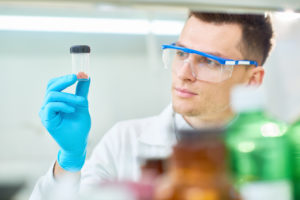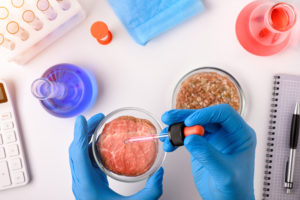The rising environmental cost of cattle meat production, emergence of multi-drug resistant bacteria from overusing antibiotics in livestock, and pressure from supply chain disruptions during the COVID-19 pandemic are accelerating developments in cultured meat, a form of animal-free meat alternative. Cultured meat is also known as in vitro meat, lab grown meat, cultivated meat, or synthetic meat.
In 2013, Mark Post, PhD, professor at Maastricht University, unveiled the first cultured meat patty grown from cells on television. Seven years later in 2020, Singapore became the first country to approve lab grown chicken bites from Eat Just. As an industry, cultured meat is expected to reach a market size of about $570 million in 2025.
“Cultured meat has the potential to address all of the externalities associated with conventional industrial meat production—from environmental impacts and animal welfare considerations to public health risks associated with zoonotic disease and antibiotic resistance—while ensuring a scalable and secure production system to meet the anticipated growth in demand for animal protein,” says Liz Specht, director of science & technology at the Good Food Institute.
“Cultured meat also ultimately offers the opportunity to create meat products that are more well-defined, tunable, and potentially healthier than meat products today, which are constrained by the biological limitations of the domestic animals from which they are derived.”
Owing to advances in industrial-scale cell culture process, the production of cultured meat has been largely standardized. Typically stem cells are first seeded into extracellular matrix scaffolds usually made of edible biomaterials like collagen and chitin. To support cellular metabolic activities, culture media containing nutrients like glucose and sera are next added to the bioreactor where continual mechanical motion facilitates good diffusion of nutrients and oxygen into and removal of metabolic waste products from the cells. After about 2–8 weeks, the cells grow into tissue layers and can be harvested and packaged.
Challenges in cultured meat production
Several key challenges remain in producing cultured meat including access to (proprietary) cell lines, high raw material cost, animal-source nutrients, and limited manufacturing scale. Despite this, immense progress has been made over the last decade. Here, we discuss the challenges and solutions to deliver cultured meat from a lab bench to a dining table.
Cell lines are commonly used in the biotech industry for production of biological materials including viruses and proteins. For cultured meat, stem cells are used as they can divide indefinitely and can be differentiated into different types of lineages—just like meat from different organs. Adult stem cells can be sourced directly from the parts of animals such as muscles, liver, and adipose tissues. Alternatively, pluripotent stem cells can be obtained from embryos or de-differentiated from fibroblasts into induced pluripotent stem cells.

Emerging transgene-free technology such as microfluidics and nano-structures which can deliver genes at high throughput and efficiency are being developed to overcome this technical limitation. Hur and colleagues recently described an inexpensive (< $1) microfluidic system that makes use of cell stretching to delivery genes into stem cells at a scalable throughput of a million cells/min. Likewise, high aspect-ratio nano-structures can also facilitate efficient, minimally perturbative gene delivery into stem cells.
Second, cell line characterization is not well standardized which can adversely affect quality control. When cells divide more rapidly, there is a higher probability that their genetic content is not stable. For instance, during DNA replication, there can be copy number variations and large insertions or deletions that can lead to undesirable phenotypic and functional changes. Advanced techniques such as single cell genomic and epigenomic sequencing and transcriptomics can reveal differences even among cells belonging to the same cell line to understand stochastic heterogeneity in cells.
Culture conditions can also be modified and coupled with single cell sequencing methods to discover the roles of genes and their impact on cellular phenotypes. As the price of sequencing drops, data from these techniques would likely establish a benchmark to evaluate genetic stability of cell lines for quality control.
Biomaterial scaffold
Scaffolds are extracellular matrix materials that support the anchorage and physiological activities such as differentiation of stem cells. The biophysical properties of scaffolds are crucial to facilitate access to nutrients and oxygen while permitting diffusion of metabolic waste products. Tissue engineers have built on their knowledge in tissue engineering for wounds and organ regeneration for cultured meat production.
There are two general types of scaffold materials—naturally-derived or synthetic. Naturally-derived scaffolds like chitosan and cellulose are edible, biodegradable, food-safe, and cheap. However, as they are derived naturally, there is a greater variation in their properties such as molecular weight and degree of polymerization. This can lead to inconsistencies in how these scaffolds interact with cells. On the other hand, synthetic scaffolds can be chemically programmed into desirable materials with defined properties like porosity and ligand availability. However, as their synthesis process is more complex, the cost is higher and getting regulatory approval is also expected to be harder.
A proposed solution is a hybrid model where naturally-derived biomaterial is used as base material and a small amount of synthetic material is added to enhance the compatibility with cultured cells. Advanced manufacturing methods like 3D printing can also be used to “print” scaffolds with defined properties.
It is extremely difficult to create a thick tissue layer because there is little to no vascularization in cultured meat. Consequently, when the tissue layer becomes too thick, cells at the core of the tissue suffer from a lack of nutrients and oxygen. Computational analyses have been applied to understand the optimal scaffold pore size, topography, and material shape to facilitate vascularization in tissue layers and/or promote nutrient and waste production diffusion.

“First, plunge micro needle arrays into thick tissue layers or incorporate vasculature like perfusable features into scaffold or bioreactor design. Second, use cell-sheet tissue engineering approaches to grow thin enough sheets of tissues and then integrate them into food. Third, adopting bottom-up approach to engineer small tissue building blocks and integrate into food so there is no need to worry about the diffusion limit in thick layers,” says Yu.
Yu, however, stresses that, the dominant voice in the field is using a top-down approach where cells are being seeded into a large piece of scaffold and grown into thick tissue layers. “Based on my experience as a tissue engineer over the last few decades, I don’t foresee that we can use a top-down approach at a cost-effective manner for growing cultured meat,” he adds.
Growth media recipes
As cell lines divide rapidly, growth media needs to be able to supply them with high concentrations of essential nutrients including glucose, amino acids, and vitamins. Commercial growth media is costly, and a lack of better alternative has kept the prices of cultured meat high. In addition, while cultured meat is purported as an animal-free meat alternative, in reality, its production may still require animal source materials such fetal bovine sera. Sera is a complex mixture of multiple types of amino acids, lipids, inorganic mineral, and growth factors that cannot be easily or cheaply manufactured, and this has made it challenging for it to be replaced in cultured meat manufacturing.
Kuo et al., described a culture medium recipe containing fibroblast growth factor 2, transforming growth factor β3 and neuregulin 1 for induced pluripotent stem cells that can be produced with just 3% of the costs of commercial media. Importantly, the medium recipe was able to sustain more than 100 passages of cell division and weekend-free feeding without compromising the differentiation capacity of 34 different types of stem cells.
Through technological developments, researchers are also exploring ways to scale up production of recombinant proteins like growth factors at a lower cost using genetically engineered microbes, fungi, or plants to circumvent animal sources. There are also research groups who have develop growth culture media that is entirely void of serum. Kolkmann and colleagues developed a chemically-defined, serum-free media which supported bovine myoblast proliferation exponentially, albeit not as fast as media with 30% serum content.
Bioreactors provide controlled culture environment such as temperature, pH, and even mechanical motion to optimize cell growth. They are an important element in the cultured meat industry to achieve scalable production to meet consumer demand. Stephens et al., estimated that, for instance, to produce 1 kg of protein from muscle cells, 8 x 1012 cells would be needed and that would require a stirred tank bioreactor in the order of a few thousand liters.
Although bench-top bioreactors have so far been quite successful in meeting current demand for cultured meat, as the demand increases, greater innovation is warranted in bioreactor design. In addition, most commercial bioreactors are designed for growing suspension cells or cells anchored onto micro-carriers, and not scaffold materials with thick tissue layers. This makes it challenging to directly adapt available designs for cultured meat production due to system incompatibility like diffusion limits.
Nevertheless, past experiences can inform bioreactor designs for cultured meat manufacturing. For instance, it would be beneficial to introduce mechanical agitation such as stirring or wave rocking motion to improve nutrient diffusion. Perfusion bioreactors that continually supply nutrients and remove waste products are also better for growing thick tissue layers. Single-use bioreactors can also be considered to minimize contamination and for quicker and cheaper optimization of culture conditions.
The future of cultured meat
Cultured meat provides a hope that our society can become less reliant on animals for meat, thus reducing the environmental and health impact of animal farming. There are still major scientific challenges including developing quality cell lines, lowering the costs of growth media components, and designing bioreactors for growing thick tissue layers before cultured meat can become a common food product. Nevertheless, there is room for optimism.
“In the past few years, we have seen a rapid acceleration of interest in cultured meat research by academic researchers and startup companies. This emerging field is also increasingly capitalizing on the ability to work collaboratively on pre-competitive research angles that will accelerate the whole landscape. At the Good Food Institute, we facilitate seminars and collaborative networking opportunities and curate resources like research tools directory and directly fund research to address key knowledge gaps and develop open-access research tools,” says Specht.
Sophisticated technology in genetic engineering, biomaterial design and sequencing methods can offer effective technical solutions. Greater scientific solutions are also expected with increasing investments in the science of alternative food. Importantly, beyond the science, for cultured meat to become a common market commodity, challenges in regulations and consumer acceptance must still be overcome.


